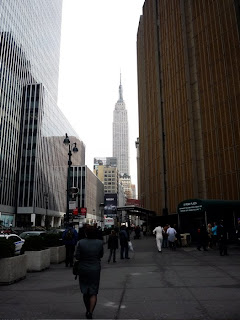George Tooker and Ralph Albert Blakelock at The National Academy Museum
 Visitors to Museum Mile this fall should stop in the National Academy Museum at Fifth and 89th Street to see the remarkable George Tooker retrospective. While there, also find the set of stairs at the back of the exhibition galleries to see the landscapes of Ralph Albert Blakelock (1847-1919).
Visitors to Museum Mile this fall should stop in the National Academy Museum at Fifth and 89th Street to see the remarkable George Tooker retrospective. While there, also find the set of stairs at the back of the exhibition galleries to see the landscapes of Ralph Albert Blakelock (1847-1919).The building itself is noteworthy. In 1942 the museum moved into this Fifth Avenue mansion, once the home of Archer Milton Huntington and his wife, the sculptor Anna Hyatt Huntington. In 1913, Huntington hired architect and interior designer Ogden Codman, Jr. to expand the space. Codman, a friend and collaborator of novelist Edith Wharton, refashioned the space in French Renaissance Revival and neo-Grec styles. The Huntingtons lived in the space until 1939 when they gave the space to the museum. The National Academy Museum offers regular tours of the house.
But by all means, visit the revelatory George Tooker exhibition before it closes at the beginning of January 2009. An American artist of multicultural heritage, Tooker explored social issues such as civil rights, injustice, homophobia, and the bureaucratic state through a not-quite-realist representational art. Heavy in content and rich in composition, his meticulously-made paintings of post-war alienation are filtered through the ways and means of Renaissance painting. His chosen medium of egg tempera fosters a creamy richness to his vibrant colors, and his carefully delineated brush strokes compel long viewings of individual paintings.
 So much to see and discover with sixty or more paintings, but spend some time taking in the works considered his masterpieces - Subway (1950) and Government Bureau (1956). Subway depicts a woman front and a little off center, clad in a red dress and blue coat as she nervously looks around the station. Behind her and to her right and left, figures, mostly men, seem interchangeably alike. The ceiling presses low. She's holding her stomach, as if suffering from morning sickness. The image suggests the impersonal city of the post-war era, but undeniably, Subway also invites a religious reading with a Madonna making her way home. Government Bureau, based on the artist's frustrations with securing the needed work permits to renovate his house, exudes the same sort of impersonal world. In depicting the power of the bureaucrats sitting in their cubicles, only their menacing faces appear in the circle within each partition. Tooker renders these identical "faceless" bureaucrats with old and menacing eyes. Tooker's carefully-planned sketches for the paintings reveal not just his thought processes and attention to detail but a passion for the science of Renaissance perspective.
So much to see and discover with sixty or more paintings, but spend some time taking in the works considered his masterpieces - Subway (1950) and Government Bureau (1956). Subway depicts a woman front and a little off center, clad in a red dress and blue coat as she nervously looks around the station. Behind her and to her right and left, figures, mostly men, seem interchangeably alike. The ceiling presses low. She's holding her stomach, as if suffering from morning sickness. The image suggests the impersonal city of the post-war era, but undeniably, Subway also invites a religious reading with a Madonna making her way home. Government Bureau, based on the artist's frustrations with securing the needed work permits to renovate his house, exudes the same sort of impersonal world. In depicting the power of the bureaucrats sitting in their cubicles, only their menacing faces appear in the circle within each partition. Tooker renders these identical "faceless" bureaucrats with old and menacing eyes. Tooker's carefully-planned sketches for the paintings reveal not just his thought processes and attention to detail but a passion for the science of Renaissance perspective.The Unknown Blakelock, also on display, showcases the talents and moody preoccupations of a talented nineteenth-century landscape painter. The accompanying text indicates that the work of Ralph Albert Blakelock is often overshadowed by his troubled story, namely his mental issues, most likely schizophrenia. He continued to paint while committed to a sanatorium. Blakelock is most famous for moonlit landscapes, so the "unknown" component here encompasses seascapes, fantasy paintings, and other subjects. At any rate, his paintings share many qualities of the Hudson River school as well as a kinship with those of Albert Pinkham Ryder, but his rocky, highly textured, and almost nervous and chaotic brushstrokes send the representations into a land of symbolic abstraction.
George Tooker: A Retrospective and The Unknown Blakelock continue through Jan. 4 at the National Academy Museum, 1083 Fifth Avenue, at 89th Street.
Images by Walking Off the Big Apple.





Comments
Post a Comment